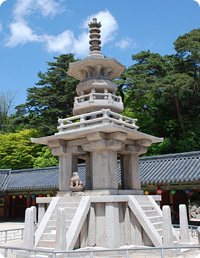WINTER OLYMPICS
Pre-Olympics 4 days
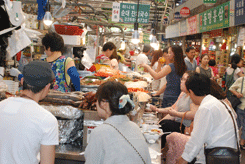
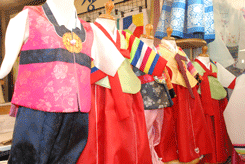
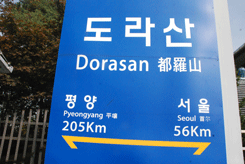
Click on the days to access the programs quick
| Days | Visits and Activities | Distance |
| Day 1 | Arrive Seoul | 60km |
| Day 2 | Seoul | |
| Day 3 | Seoul - DMZ - Seoul | 140km |
| Day 4 | Seoul - Pyeongchang | 220km |
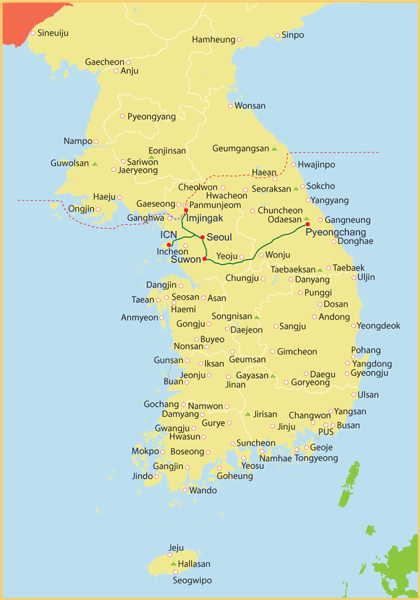 Day 1 Arrive Seoul (- - -) 60km
Day 1 Arrive Seoul (- - -) 60km
Touching down at Incheon International Airport, and after arrival formalities, you are met and transferred to your hotel.
Day 2 Seoul (B)
Your exploration this morning begins with a driving tour of Seoul, featuring sites such as Seoul Plaza, City Hall, Cheonggye Square and pedestrian-friendly Gwanghwamun Plaza that is hemmed in on both sides by rushing traffic and office buildings. The plaza is lined on each side with 365m long streamlets, two centimeters deep and one meter across, the stone bed of the plaza's east side waterway engraved with important events in chronological order from 1392 to 2008.
Standing high on a stone pillar is a statue of Yi Sunsin who had engaged in twenty-three naval battles and emerged victorious in all of them during the Hideyoshi invasion (1592-1598). King Sejong who propagated the Korean alphabet in the 15th century is also honored with prominent statue. On August 16, 2014, Pope Francis celebrated Mass in this plaza to beatify 124 Korean martyrs. Near the southwest corner of the plaza is Korea's Kilometer Zero, marking the distances to 64 cities around the world, including Seoul's antipode, Montevideo, Uruguay, 19,606km.
Step back in time to when life was gracefully slow and discover Gyeongbokgung palace, a particularly charming spot that represents a colorful and turbulent side of the capital's 500-year history. Depending on timing, you may witness the Royal Guard Changing Ceremony featuring parade, password verification, duty shift and patrolling the gate. Accompanied by a court band with its colorful costumes and royal flags, the ceremony is performed daily basis at 10:00 and 14:00 except Tuesdays, although it is cancelled in case of rain or extremely hot or cold weather.
The throne hall stands majestically on top of a two-tiered stone platform. At the back of this hall is a group of offices. Displayed in front of the King's official quarters is Angbuilgu. Check out this interesting sundial and learn how to tell time and 24 periods of seasonal change from the winter solstice to the summer solstice.
Sitting on the island in the rectangular lake is Gyeonghoeru. Supported by 24 each square and cylindrical massive stone pillars representing the idea of Yin and Yang, this magnificent pavilion was used for many purposes ranging from receptions to national examinations. Gangnyeongjeon is the king’s sleeping and living quarters while Gyotaejeon is the queen's domain containing a number of halls. The noted feature of these main buildings is an absence of a top roof ridge. You cannot miss Amisan Garden landscaped with four hexagonal chimneys in orange bricks which are seldom noticed by the hurried visitors. Jagyeongjeon is the queen dowager's residence. Although less colorful, it is worth noting the wall of Jagyeongjeon, adorned with floral designs and the chimneys with ten longevity symbols.
Hyangwonjeong features a small pond with a manmade islet that supports a beautiful two-story pavilion. Behind this serene garden is Geoncheonggung, where the king and queen could relax in peace and quiet. It was here that the first electric lights in the country were installed in 1887 after 8 years of Thomas Edison's invention and a tragic chapter in Korea's history was recorded when empress Myeongseong was assassinated by the sword-bearing Japanese assassins in the early morning of 8 October 1895, allegedly under orders from Miura Goro.
Your visit to the National Folk Museum of Korea will familiarize you with wealthy culture of this friendly and picturesque nation. It is an excellent facility to illustrate the history of traditional life of the Korean people from the prehistoric age to the Joseon dynasty. The permanent exhibition features life and work, costumes and ornaments, handicrafts and technology, educations, living quarters, dietary life, oriental medicine, performing arts and games, beliefs and rituals, and socio cultural life.
Jogyesa is the head temple of Jogyejong the principal sect of Korean Buddhism, emphasizing the Zen orthodox, meditation tradition and the purity of monastic celibacy. The Main Worship Hall holds triad Buddhas, Sakyamuni, Amitabha and Bhaisajyaraja. The figure in the center is Sakyamuni Buddha who has overcome greed, hatred and delusion. While here it is worth noting the 500 year old lacebark pine and 400 year old locust tree that still grace the property.
Insadong, at one time the center of traditional Korean art and antiques, features a mixture of historical and modern atmosphere representing the cultural glimpse of the nation. Clustered along the main street and alleys are lined with street vendors, wooden tea houses, restaurants and numerous galleries and shops dealing in antiques, oriental art supplies, and modern Korean art of all types and styles. Soak in the paintings, upscale artworks, antiques and potteries while you can. Get lucky and you just might meet the artist themselves. It can be plenty of fun walking on the main street, but you venture into the hidden alleys that do spring some unexpected surprises. While here, you may want to buy some souvenirs or simply wander and browse at leisure admiring cultural ambience.
Enjoy a brief visit to Gwangjang market. It is one of few markets retaining traditional Korean atmosphere. Established in 1905, the market today has 5,000 independent shops. On the market's ground level, the floor space is dominated by scores of small snack stalls selling rustic delicacies and cheap treats. Clouds of smoke billow out from the boiling pans, diverse types of pancakes sizzle on hot iron grills and the smell from the eateries filling the air. The roadside vendors hawking everything from food, fruits, vegetables to seafood and an entire upper level dedicated to high quality silk, satin, and linen. Try out some sorts of Korean snacks and see a side of regular Seoul life.
Drive past Cheonggyecheon Stream. After the Korean War (1950-1953), more people migrated into Seoul to make their living and settled down along the stream in shabby makeshift houses. The accompanying trash and waste, and deteriorating conditions resulted in an eyesore for the city. The stream was covered with layers of concrete in the mid 1950s and roadway until the massive urban renewal project freed it in 2005. Today, a 5.8km creek tumbles gently through downtown Seoul, providing a much needed source of peace and relaxation for the citizens of this fast-paced city.
Day 3 Seoul - DMZ - Seoul (B) 140km
Please note that the DMZ is a politically sensitive area, and is therefore not always open to tourists.
In the event that the area cannot be visited, alternate sightseeing will be arranged.
Rules and Regulations |
 Your touring today will be private today until you reach Imjingak, at which time you will board a bus with other tourists as private tours of the tunnel and DMZ area are not allowed. Your private tour guide will remain with you throughout the day.
Imjingak is the furthest north point in the area than you can go freely, and a park with an array of monuments and statues that speak to the Korean War (1950-1953).
Your touring today will be private today until you reach Imjingak, at which time you will board a bus with other tourists as private tours of the tunnel and DMZ area are not allowed. Your private tour guide will remain with you throughout the day.
Imjingak is the furthest north point in the area than you can go freely, and a park with an array of monuments and statues that speak to the Korean War (1950-1953). One such monument is Mangbaedan, a memorial site where displaced North Koreans pray for their ancestors. Near Mangbaedan is the Freedom Bridge, and was an important site where 12,773 prisoners of war returned to freedom. This short, sturdy wooden structure ends at a barricade, which embodies the North. The altar and the bridge now serve as places of remembrance for displaced families, and the millions of bright colored ribbons tied to the fence have messages of hope, dreams and wishes for unification between South and North Korea.
You can also see a derelict locomotive engine shot full of bullet holes and its bent wheels - not particularly special in any way other than it shows the destruction of war. Having been left in the DMZ since bombs derailed it during the Korean War; it was cleaned up and moved here in 2009. There is a collection of stones from 86 battlefields in 64 countries known as the Peace Stones that have witnessed suffering and grief of war.
Then, you board a tour bus to continue on to the Demilitarized Zone which straddles the South and North Korean border. A 4km wide buffer of land stretches the breadth of the Korean peninsula. Total 1,292 signboards of the Military Demarcation Line were established and 696 of which are controlled by the U.N. Forces while 596 are under the control of North Korea and China. Although an Armistice came into effect in July 1953, the two Koreas are still technically in an active state of war. Tensions between the two countries remain high, and the border is patrolled by thousands of troops on both sides. Before being allowed to enter the DMZ, you will have to obtain passport and security clearance at the Unification Bridge, the first control line with sentries and photo opportunities will be limited.
The 3rd tunnel is one of the four infiltration tunnels dug by the North to facilitate an invasion of the South. Discovered on October 17, 1978, it is a 1,635m long, 2m high and 2m wide, and could have accommodated 30,000 soldiers per hour in what was apparently designed for a surprise attack on Seoul. The tunnel runs through bedrock at a depth of about 73m below ground; 435m of which are found in the South over the Military Demarcation Line (MDL). It is designed at a three thousandth angle with northern side lower than southern side, so that water does not stagnate inside tunnel. After ducking and crouching your way 265m through the tunnel, you will reach one of the cement walls with iron door near the MDL that will prevent you from going any further north and where you peep through a small window at a barricade, just to see another barricade in the distance. You can clearly see the drill marks for dynamite all pointing toward the South. This finding, along with other clues, clearly affirmed their construction.
After exploring the tunnel, climb back out of the tunnel and make your way to the DMZ Exhibition Hall for a unique insight into the Korean War and model of soldiers digging the tunnel, equipment used by the North, model of Panmunjeom (Joint Security Area), a timeline of major North Korean provocations over the South since 1950, and photographs of the historical events about Korea's division. And time for a short video including old film that takes you back in time to the signing of the armistice and the creation of the DMZ.
Next stop is Dora Observatory. As you approach, you will see an eye catching slogan printed up on the wall "End of separation, beginning of unification". The observatory looks across the land north of Demilitarized Zone, the road and train track stretched side by side ahead into the North Korea, bare mountains, treeless hills, watchtower, North Korean propaganda village and Kaeseong Industrial Complex. Financed and managed for the most part by South Korea, the project was launched in 2004 as a gauge of the volatile security situation on the peninsula, and South Korean companies could manufacture their products using North Korean labour. It once employed 803 South Korean and 54,764 North Korean workers, but this jointly run Industrial complex is totally shutdown as of February 10, 2016 in response to North Korea's nuclear test.
There are two heavily guarded villages in the DMZ, Daeseongdong farming community in the south and Gijeongdong propaganda village in the north, which face each other across the minefields. Each village hangs their government's flag upon some of the tallest flagpoles in the world - what some have come to call the "flagpole war." In 1981, the South Korean government built a 99.8m-tall flagpole with a 130kg (18m x 12m) South Korean Flag. The North responded by building a 160m-tall flagpole with a 270kg (30m x 14m) flag. It was superseded as the world's tallest, following the construction of the flagpole in Baku's National Flag Square at 162m. Both flagpoles were topped in 2011 by the Dusanbe Flagpole in Tajikistan at 165m.
You will also tour the Dorasan Station, the last railway station in South Korea before the North Korean border. This station drew world attention when President Bush visited here in February 2002. On December 11, 2007, freight trains began traveling north past this station into North Korea, however, on December 1, 2008, the North Korean government closed the border crossing. The station is heavily guarded and signs are up showing the future destination of Pyeongyang in North Korea. The milepost "Seoul 56km/Pyeongyang 205km" still stands from the time when trains could still cross past this station and into North Korea.
Day 4 Seoul - Pyeongchang (B) 220km
With leisurely time to pack, tranasfer to the hotel of your choice in Pyeongchang.





